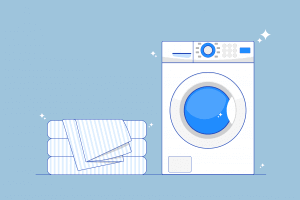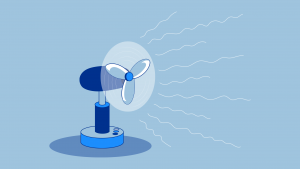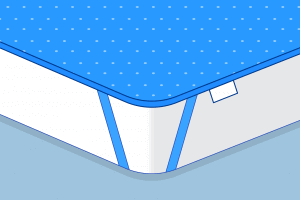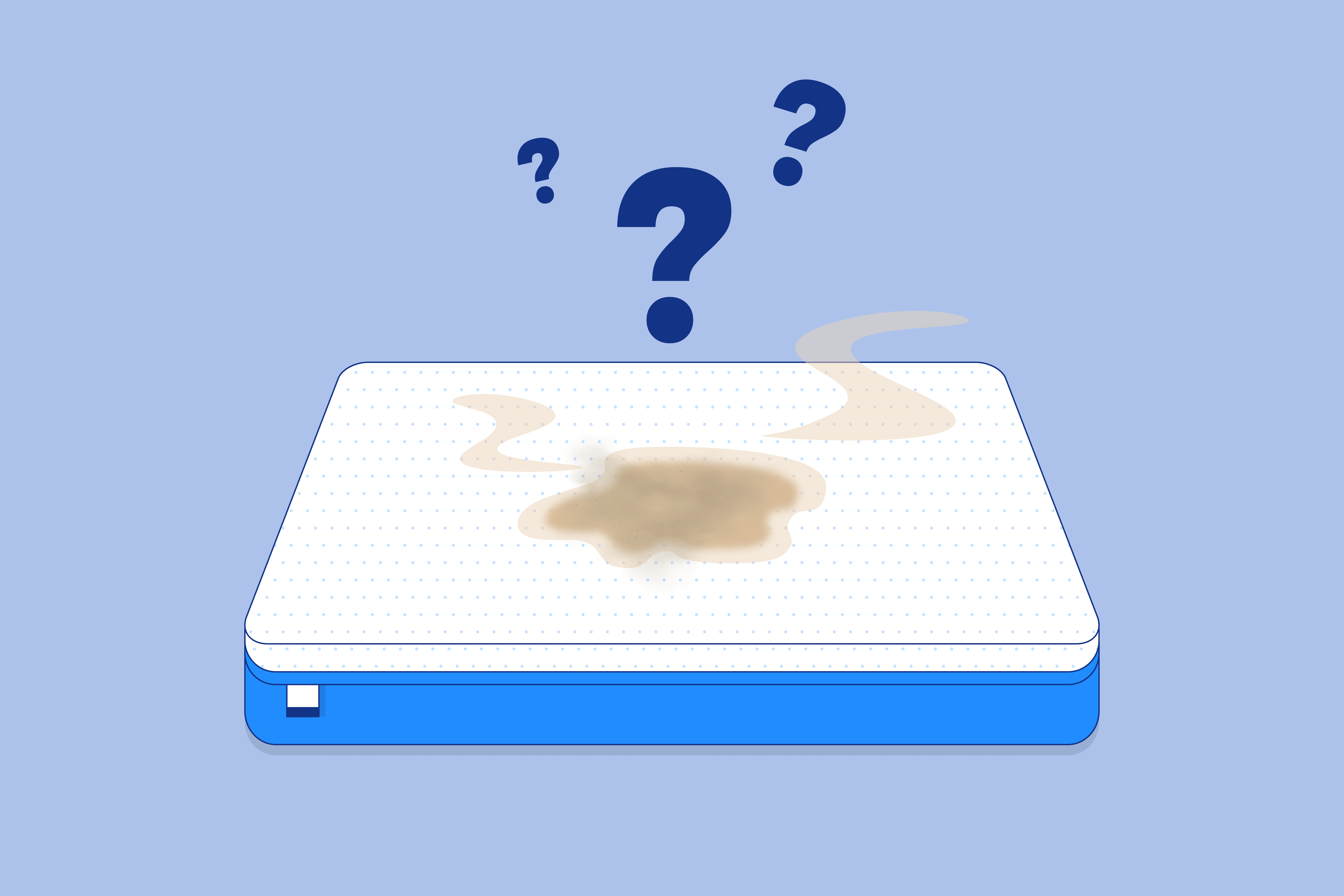Key Takeaways
- Dispose of Solid Waste: When dealing with poop stains on a mattress, first remove any solid waste with disposable gloves and paper towels, disposing of them in a sealed plastic bag.
- Choose Your Cleaner Carefully: Enzyme cleaners or hydrogen peroxide solutions are effective for removing poop stains, but avoid using bleach as it can damage the mattress.
- Thoroughly Clean and Deodorize: Blot the stained area with your chosen cleaner, rinse, and deodorize with baking soda and white vinegar. Disinfect it with rubbing alcohol and ensure the mattress is dry before using a mattress protector.
As unpleasant as it may be, dealing with poop stains on your mattress is an inevitable part of life for many pet owners, parents of young children, and caregivers of incontinent adults. Even certain illnesses like the stomach flu or chronic conditions like inflammatory bowel diseases can leave you scrambling to clean up your own mess in bed.
While it may seem an unappealing task to clean up poop and other accidents, it is possible to restore your mattress to what it was before an accident occurred. Cleaning these stains promptly and properly can help salvage your mattress and eliminate any lingering smells or bacteria.
In this comprehensive guide, we’ll walk through all the steps needed to get poop stains out of your mattress completely. With the right products and techniques, you can restore your mattress to a clean, odor-free state.
Quick Guide: A 30-Second Summary
| Best Stain-Proof Mattress Protector | Amerisleep Mattress Protector |
Dispose of Solid Waste
Start by gathering up gloves, paper towels, and a plastic bag and removing any solid waste from the mattress. Putting on disposable gloves will keep your hands protected when handling fecal matter and soiled bedding.
Remove any solids carefully by picking them up with a paper towel. Try to avoid smearing the waste and creating a larger stain. Dispose of the paper towels and any solid waste in a sealed plastic bag.
Assess the Stain
 Your next step is to assess the location and severity of the staining.. If the stain is fresh or still contains solid waste, remove them. Be gentle to avoid spreading the stain.
Your next step is to assess the location and severity of the staining.. If the stain is fresh or still contains solid waste, remove them. Be gentle to avoid spreading the stain.
For liquid stains or dried staining, identify how far the stain has spread. You may need to treat just a small oval area or a larger patch depending on the amount of feces.
Also, check whether the stain has soaked through all layers of the mattress or just the surface. Press paper towels around and under the stain to see if you can blot up any moisture.
Choose Your Cleaner
 For the mattress itself, enzyme cleaners are highly effective at breaking down organic matter like feces or urine stains and eliminating odors. Look for pet mess cleaners if you’re dealing with an accident from your dog or cat. They use bacterial enzymes to digest waste compounds.
For the mattress itself, enzyme cleaners are highly effective at breaking down organic matter like feces or urine stains and eliminating odors. Look for pet mess cleaners if you’re dealing with an accident from your dog or cat. They use bacterial enzymes to digest waste compounds.
Hydrogen peroxide is another excellent cleaning and disinfecting option. Mix a solution of 2 parts hydrogen peroxide to 1 part water. For lighter stains, mix with a bit of dish soap.
While it can be tempting to use it to obliterate a poop stain, we cannot recommend using bleach as a solution. Even diluted bleach can be harsh on fabrics and materials, potentially causing damage to the mattress.
Plus, mattresses are typically designed to be absorbent, and bleach can leave behind residue or lingering odors, even after thorough rinsing. Moreover, bleach can weaken the fibers and compromise the structural integrity of the mattress, shortening its lifespan.
Avoid drenching the mattress interior and focus on blotting cleaners onto the surface.
Remove and Wash Bedding
 Before cleaning the mattress, strip off all bedding and wash it. Use an enzyme cleaner or odor eliminator to pretreat any poop stains on sheets, mattress pads, blankets, or other bedding. Allow this cleaning solution to soak for 10 to 15 minutes.
Before cleaning the mattress, strip off all bedding and wash it. Use an enzyme cleaner or odor eliminator to pretreat any poop stains on sheets, mattress pads, blankets, or other bedding. Allow this cleaning solution to soak for 10 to 15 minutes.
Then, wash the bedding on the hottest setting recommended for the material, as provided by the laundry care label and washing symbols. This hot water wash will kill bacteria and help clean poop stains. Add a sanitizing laundry booster if desired to your load.
See also:
- How to Wash a Body Pillow
- How to Wash a Quilt
- How to Clean an Electric Blanket Safely
- How to Clean a Weighted Blanket
- How to Clean a Comforter
- How to Wash a Duvet
- How to Make Sheets White with Household Items
- How to Wash and Dry All of Your Pillows
- How to Get Pet Hair Out of Bedding
- How Often Should You Wash Your Sheets?
- Can You Wash Sheets with Clothes and Other Items?
Rinse and Deodorize
Once the surface stain is removed, rinse the area with clean water on fresh paper towels or rags. Blot gently to remove any cleaner residue.
Baking soda can then be sprinkled liberally over the area and left to sit overnight. The baking soda will help draw out lingering odors and moisture. Let the baking soda sit for 8 to 12 hours before vacuuming away.
For extra odor elimination, make a solution of one part white vinegar to three parts water in a spray bottle. Spritz this over the affected area and allow it to air dry. The vinegar smell will dissipate as it dries while removing any lasting poop odors, freshening and deodorizing the mattress.
Remove Mattress Cover
If the mattress has a removable outer cover meant to be washed, you may be able to take this off and wash it after treating the interior layers. A mattress cover protects the inner layers, and you may be able to replace just the cover if it’s too soiled.
However, it is essential to check that you have a fiberglass-free mattress first. Otherwise, glass particles can escape and cause irritation.
You will also want to double-check that removing the mattress cover does not void the mattress warranty.
Check the care tag and wash the mattress cover in the hottest water recommended, adding bleach or sanitizer if safe for the fabric. Make sure to dry it fully before placing back on the mattress, to deter mattress mold growth.
Clean & Blot Stained Areas
With your cleaner ready, start treating the stained regions of the mattress surface. For an enzyme-based cleaner, lightly mist over the stain and surrounding area. Give it 5 to 10 minutes to start interacting with waste compounds before blotting with a clean cloth or sponge.
For hydrogen peroxide or other liquid solutions, dip clean cloths into the mixture and blot carefully onto any brown stains. Apply moderate pressure as you blot outward from the stain center to lift discoloration.
Reapply cleaner and continue blotting with fresh paper or cloth towels until no more stains transfer. Take care not to oversaturate the mattress. Particularly if you have a memory foam mattress.
Rinse, Deodorize and Absorb Moisture
Once stains are no longer visible on the surface, rinse thoroughly with clean water applied via a spray bottle or wet towels. Blot gently to soak up excess moisture.
Baking soda can then be sprinkled liberally over the affected area. Allow it to sit for 6 to 12 hours. Sprinkling baking soda will help wick away moisture and neutralize odors and is easy to clean up with a standard vacuum cleaner.
For extra deodorizing power, make a solution of one part white vinegar to two parts water. Spray this vinegar solution over the area and let dry fully. The vinegar smell disappears as it dries.
Speeding Up Dry Time

Allowing adequate drying time is crucial after deep cleaning to prevent mold or mildew growth inside a mattress. Place the mattress in direct sunlight on dry days or use multiple portable fans blowing air across the surface to accelerate water evaporation, leaving a fan on at night if needed.
A dehumidifier in the room will help pull moisture from the mattress interior. Drying the mattress fully could take 24 hours or longer depending on the degree of saturation. Rotating the mattress while drying ensures even air circulation.
Be patient and periodically check for hidden damp areas, especially if you have a dense memory foam mattress that is more likely to retain moisture.
Disinfecting the Mattress
As a final disinfecting step once fully dry, use rubbing alcohol (isopropyl alcohol) to kill any lingering bacteria in the bed. Dilute the rubbing alcohol with an equal part of water and spray over the affected region. We recommend a small patch test first on an inconspicuous part of the mattress to avoid discoloration.
Then, allow the solution to fully air dry. The alcohol evaporates as it dries, leaving no scent behind.
Prevent Messes with a Mattress Protector
 Going forward, protect your cleaned mattress with a waterproof mattress protector. Choose one made of a non-porous material that can simply be wiped clean or machine-washed in the event of future accidents. This saves your mattress from re-staining, along with keeping dust mites, mold spores, and other allergens from setting up house in your bed.
Going forward, protect your cleaned mattress with a waterproof mattress protector. Choose one made of a non-porous material that can simply be wiped clean or machine-washed in the event of future accidents. This saves your mattress from re-staining, along with keeping dust mites, mold spores, and other allergens from setting up house in your bed.
Place absorbent mattress pads or incontinence pads over the protector for another layer of protection against the unexpected wet fart as you sleep.
This is particularly if there is a high risk of a repeated incident due to a chronic disease like Crohn's disease Verified Source Medline Plus Online resource offered by the National Library of Medicine and part of the National Institutes of Health. View source or ulcerative colitis. Verified Source Medline Plus Online resource offered by the National Library of Medicine and part of the National Institutes of Health. View source
A mattress protector also minimizes the work you have to do cleaning up other messes, as our mattress cleaning guides cover. See also:
- How to Remove Blood Stains on Your Mattress
- How to Remove Urine Stains and Smell From a Mattress
- How to Clean Vomit from a Mattress
- How to Get Sweat Stains Out of a Mattress
- How to Clean Water Stains from a Mattress
- How to Remove Coffee Stains from Your Mattress
- How to Remove Makeup Stains from Mattresses
- How to Remove Ink Stains from a Mattress
- How to Fix a Ripped Mattress
- How to Clean a Dusty Mattress
It’s smart to wash your protector after cleaning up any sort of bodily mess, to ensure nothing unwanted lingers in your bed.
FAQs
Should I lay in bed if I have diarrhea?
If you’re experiencing diarrhea, we’ve found that it’s generally best to avoid lying in bed for extended periods, especially if you have urgent or frequent bowel movements. Prolonged lying down can make it harder to control bowel movements, potentially leading to accidents and discomfort.
Bed rest might be necessary if you’re feeling very weak or fatigued, but it’s essential to balance rest with regular trips to the bathroom. If you feel the need to rest, try propping yourself up with pillows or use an adjustable bed to stay in a semi-upright position, which can help reduce pressure on your abdomen and improve comfort. Aside from sitting up while resting, make sure you stay hydrated, too.
When should I be worried about my poop?
Pay attention to persistent and unexplained changes in your pooping habits. This includes ongoing issues like diarrhea, constipation, significant alterations in stool color, or a noticeable increase or decrease in the frequency of bowel movements.
Such persistent changes can be indicative of underlying gastrointestinal conditions such as irritable bowel syndrome (IBS), inflammatory bowel disease (IBD), or even colorectal cancer in some cases. Also, if you observe blood in your stool, whether it’s bright red or dark and tarr, it’s a serious cause for concern and should never be ignored.
What are the orange stains on my mattress?
If you happen to spy brown or orange spots on the bed, it may not be poop stains but rust from the coils supporting your mattress surface. The stain may also smell faintly metallic if the culprit is rust. Mattress rust stains occur when metal bed frames or interior mattress springs are exposed to moisture from spills, sweat, or even high humidity levels in the bedroom.
Other potential causes of orangish stains include skincare products from a nighttime skin routine, body oils and sweat, and food or drink spills.
What does mattress mold look like?
Mattress mold typically resembles dark or black spots on the mattress surface, which can vary in size and shape and may appear fuzzy or powdery, much like common household mold. Over time, you may also see these spots grow in a way that typical stains do not. You may also notice a musty or otherwise unpleasant smell coming from the mattress.
It’s important to address any mold in the bedroom immediately, as it can interfere with your breathing and have long-term effects on your health. The danger of mold means it’s also crucial to avoid overwetting your mattress when cleaning up messes and treating mattress stains.
When is a mattress too dirty to clean?
We would say that in our experience, a mattress is too dirty when it has deeply embedded stains, odors, or contaminants that cleaning alone cannot fully address. Some common examples include extensive urine or fecal stains, severe mold or mildew growth, bed bug infestations, water damage that has introduced bacteria and harsh chemicals, or deeply ingrained pet dander and allergens.
If a mattress is beyond the point of effective cleaning, it is more practical and hygienic to replace the mattress rather than attempt to salvage it. Mattresses have a finite lifespan, after all. When they reach a state where cleaning cannot sufficiently address hygiene or comfort concerns, investing in a new mattress is better to ensure a healthy and restful night’s sleep.
Conclusion
With the proper cleaning solutions and techniques, you can get poop stains out of your mattress and keep it looking and smelling fresh. Act quickly at the first sign of staining and odor to make cleanup easier and restore your mattress. Consistent mattress protector use can also save you from having to clean future stains over and over.
By following these comprehensive cleaning steps, you can successfully remove poop stains and smells from your mattress. While thorough drying and disinfecting are essential, the key is using the right enzyme or oxygen cleaner to lift the stain immediately after it occurs. With the proper products and prompt attention, you can keep your mattress looking and smelling fresh.
About the author
Geoff McKinnen is a writer focusing mainly on the healthcare industry and has written articles on everything from foods to help you lose weight to the connection between Alzheimer’s and sleep. Geoff’s passionate about helping readers improve their well-being to lead happier lives. Outside of work, Geoff enjoys cycling and hiking and believes that by leading a healthy lifestyle, he can help others do the same.
View all posts





